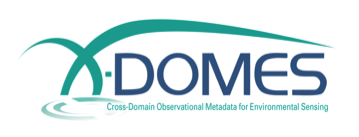Join us at the 2026 January ESIP Meeting! Register.
Cross-Domain Observational Metadata for EnviroSensing

“Standards-based description of environmental sensor metadata, including provenance, is paramount to automated data discovery, access, archival, processing, as well as quality control and assessment.”
The X-DOMES pilot project leverages existing relationships with large NSF-funded data management programs, EarthCube building blocks and working groups, and environmental sensor manufacturers and consortia. The project seeks to establish a community of sensor manufacturers and other stakeholders to provide a unifying approach to describing sensors and observations across geo-science domains. Built on an existing sensor metadata model that references registered, standards-based vocabularies, the X-DOMES pilot project is providing a suite of tools, built upon community-adopted standards of the Open Geospatial Consortium (OGC) and World Wide Web Consortium (W3C) to demonstrate and facilitate the generation of metadata documents that are discoverable and accessible on-line and/or directly from on-board sensor descriptions. We also demonstrate mechanisms to associate the data with the metadata through standards-based web services. With vendor-ready tools implemented throughout a broad-based community, the X-DOMES Network has formed the foundation for the development of and adoption of interoperable access to much needed content-rich sensor metadata.
** Stay connected by joining the ESIP EnviroSensing Cluster: http://wiki.esipfed.org/index.php/EnviroSensing_Cluster
Project Leads:
Janet Fredericks – Woods Hole Oceanographic Institution
Mike Botts – Botts, Inc.
Carlos Rueda – Monterey Bay Aquarium Research Institute
Felimon Gayanilo – Texas A&M CC
Krzysztof Janowicz – UC Santa Barbara
The ESIP Community Ontology Registry (COR) can be used to create resolvable links to key terms in describing sensors, such as sensorType, observableProperty, property, process, characteristic and capability. These are terms that can be referenced in SensorML documents.
The COR is available at: http://cor.esipfed.org/
Example SWE 2.0 content can be viewed at https://q2o.whoi.edu/node/146
( Links below are broken so use link above).RDI Workhorse – Below is a link to a generic T-RDI Workhorse 1200 and demonstrates what we call an Original Equipment Manufacturer (OEM) document.
http://opensensorhub.github.io/sensorml-editor/SensorMLEditor.html?url=h…
MVCO Workhorse – Content describes a “typeOf” RDI-Workhorse, demonstrating how it was configured and deployed (ConDEP):
http://opensensorhub.github.io/sensorml-editor/SensorMLEditor.html?url=h…
ADCP Observation System – Content describes the whole system (OEM/ConDEP/Processing):
http://opensensorhub.github.io/sensorml-editor/SensorMLEditor.html?url=h…
VIDEOS (note the YouTube videos will be updated in Aug 2017, there are some links that don't work any longer … go to xdomes.org for proper links to tools)
SensorML Editor (alpha): http://www.youtube.com/watch_popup?v=PDdWYLbFmKY
more on SensorML and diving deeper (still alpha): https://youtu.be/rAIOlx0GGNE
The videos below discuss the ESIP COR. The X-DOMES ORR works the same way – but is a space where we recommend you build your sensor related ontologies (e.g., sensor types, observable properties, etc. ). If you feel it is necessary, the ORR software can be installed to create your own ontology management system (and branded with your own institutional label) and rehosted at the ESIP COR and/or the X-DOMES ORR.
ESIP COR: Introduction: https://xdomes.tamucc.edu/video/ESIP_COR_Video_1.mp4
ESIP COR: Creating vocabularies: https://xdomes.tamucc.edu/video/ESIP_COR_Video_2.mp4
ESIP COR: New Features: https://xdomes.tamucc.edu/video/ESIP_COR_Video_3_Features.mp4
This project is funded by the National Science Foundation (NSF) as an EarthCube Integrative Activity. EarthCube is a collaboration between the Division of Advanced Cyberinfrastructure (ACI) and the Geosciences Directorate (GEO) of the US National Science Foundation (NSF). For official NSF EarthCube content, please see: http://www.nsf.gov/geo/earthcube/



